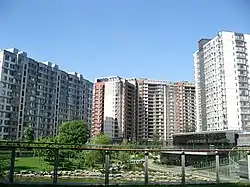Taiyanggong Area
太阳宫地区 Taiyanggong Township (太阳宫乡) | |
|---|---|
 Taiyang Xingcheng in the center of the Township, 2009 | |
 Taiyanggong Area  Taiyanggong Area | |
| Coordinates: 39°58′17″N 116°26′13″E / 39.97139°N 116.43694°E | |
| Country | China |
| Municipality | Beijing |
| District | Chaoyang |
| Village-level Divisions | 12 communities 3 villages |
| Area | |
| • Total | 5.78 km2 (2.23 sq mi) |
| Population (2020) | |
| • Total | 86,935 |
| • Density | 15,000/km2 (39,000/sq mi) |
| Time zone | UTC+8 (China Standard) |
| Postal code | 100028 |
| Area code | 010 |
Taiyanggong Area (Chinese: 太阳宫地区; pinyin: Tàiyánggōng Dìqū) is an area and township on the north of Chaoyang District, Beijing, China. It borders Wangjing and Datun Subdistricts to the north, Jiangtai Township to the east, Maizidian, Zuojiazhuang and Xiangheyuan Subdistricts to the south, Heping Street and Xiaoguan Subdistrict to the west. In 2020, it has a population of 86,935.[1]
The name of the township, Taiyanggong (Chinese: 太阳宫; lit. 'Palace of the Sun'), was first given by the Qianlong Emperor to the region during the Qing dynasty. The region also used to host Taiyanggong Temple that was demolished in the 1950s.[2]
History
| Year | Status |
|---|---|
| 1949 | Part of the 13th District |
| 1950 | Part of the 10th District |
| 1952 | Part of Dongjiao District |
| 1956 | Part of Guangming Production Cooperative Commune |
| 1958 | Part of People's Commune of Heping |
| 1961 | Separated from Heping and formed its own commune |
| 1983 | Restored as Taiyanggong Township |
| 1993 | Becoming an area while retaining township status |
Administrative Divisions
As of 2021, Taiyanggong Area has 15 subdivisions, including 12 communities and 3 villages:[3]
| Administrative Division Code | Type | Community Name in English | Community Name in Simplified Chinese |
|---|---|---|---|
| 110105024010 | Community | Shaoyaojuyi | 芍药居一 |
| 110105024011 | Community | Shaoyaoju'er | 芍药居二 |
| 110105024012 | Community | Shaoyaojusan | 芍药居三 |
| 110105024013 | Community | Huizhong'an | 惠忠庵 |
| 110105024014 | Community | Shangjialou | 尚家楼 |
| 110105024017 | Community | Taiyanggong | 太阳宫 |
| 110105024018 | Community | Shizikou | 十字口 |
| 110105024019 | Community | Niuwangmiao | 牛王庙 |
| 110105024020 | Community | Shaoyaojusi | 芍药居四 |
| 110105024021 | Community | Xiajiayuan | 夏家园 |
| 110105024022 | Community | Xibahe Beili | 西坝河北里 |
| 110105024023 | Community | Shaoyaojuwu | 芍药居五 |
| 110105024200 | Village | Taiyanggong | 太阳宫 |
| 110105024201 | Village | Shizikou | 十字口 |
| 110105024202 | Village | Niuwangmiao | 牛王庙 |
Transport
See also
References
- ↑ Zhong guo tong ji nian jian = China statistical yearbook. 2020(zong di 39 qi) 2020(No. 39). Guo jia tong ji ju, 国家统计局. (Di 1 ban ed.). Beijing: Zhong guo tong ji chu ban she. 2020. ISBN 978-7-5037-9225-0. OCLC 1262741013.
{{cite book}}: CS1 maint: others (link) - 1 2 Zhong hua ren min gong he guo zheng qu da dian. Bei jing shi juan. Li li guo, Li wan jun, Wu shi min, 李立国., 李万钧., 吴世民. Bei jing: Zhong guo she hui chu ban she. 2013. ISBN 978-7-5087-4058-4. OCLC 910451741.
{{cite book}}: CS1 maint: others (link) - ↑ "2021年统计用区划代码和城乡划分代码". www.stats.gov.cn. Retrieved 2022-09-25.
This article is issued from Wikipedia. The text is licensed under Creative Commons - Attribution - Sharealike. Additional terms may apply for the media files.